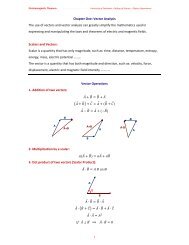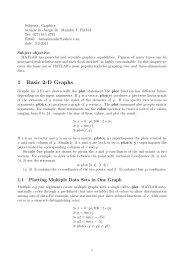Using Cumulative Count Of Conforming CCC-Chart to Study the ...
Using Cumulative Count Of Conforming CCC-Chart to Study the ...
Using Cumulative Count Of Conforming CCC-Chart to Study the ...
Create successful ePaper yourself
Turn your PDF publications into a flip-book with our unique Google optimized e-Paper software.
4<br />
V- Setting up of <strong>the</strong> <strong>CCC</strong> chart :<br />
The setting of <strong>the</strong> <strong>CCC</strong> chart is similar <strong>to</strong> <strong>the</strong> generic procedure of <strong>the</strong> setting up a<br />
Shewarthart control chart except that <strong>the</strong> measurement are <strong>the</strong> number of conforming<br />
items after <strong>the</strong> last nonconforming one . This count should be plotted only when a new<br />
conforming item is observed.<br />
Let (n) be <strong>the</strong> number of items observed before a nonconforming one is found i.e (n-1)<br />
items are conforming followed by n th item which is nonconforming .it is clear that this<br />
count follows a geometric distribution. The determination of <strong>the</strong> control limits based on<br />
this.@<br />
If <strong>the</strong> probability nonconforming item is equal <strong>to</strong> p <strong>the</strong>n <strong>the</strong> probability of getting<br />
(n-1) conforming ones following a nonconforming one is :<br />
n−1<br />
p (1 − p)<br />
n= 1,2,… …5-1<br />
The mean of geometric distribution with parameter p which can be used as <strong>the</strong> center line<br />
is :<br />
CL = 1/<br />
P @ …5-2<br />
Suppose that <strong>the</strong> acceptable of false alarm probability is α ,<strong>the</strong> UCL and LCL can be<br />
determined as :<br />
ln( α / 2)<br />
UCL =<br />
@@@@@@@@@@@@@@<br />
…5-3<br />
and<br />
ln(1 − p)<br />
ln(1 − ( α / 2))<br />
LCL =<br />
ln(1 − p)<br />
@ …5-4@ @<br />
Respectively control charts can be set up by including <strong>the</strong> control limits and <strong>the</strong> central<br />
line.<br />
If <strong>the</strong> proportion of non-conforming items a associated with <strong>the</strong> process is p, <strong>the</strong>n<br />
<strong>the</strong> probability that no nonconforming item is found in n inspected is<br />
P(no nonconforming in n items )=(1-P) n …4-5<br />
This prob. reflects <strong>the</strong> certainty we have when we judge <strong>the</strong> process <strong>to</strong> be out of control<br />
when a nonconforming item has been found. Xie and Goh (1992) introduced <strong>the</strong> concept<br />
of certainty level S,<br />
which is <strong>the</strong> probability that <strong>the</strong> process is actually out of control.<br />
The certainty level , S related <strong>to</strong> false alarm probability when interpreting <strong>CCC</strong><br />
chart signal . With one side control limit<br />
S=1- α<br />
…5-6<br />
The relation between <strong>the</strong> proportion of nonconforming items P and number of items<br />
inspected n which is given as:@<br />
( 1− p)<br />
n = S<br />
....5-7<br />
We can now determine <strong>the</strong> number of conforming items inspected before a nonconforming<br />
one is allowed for <strong>the</strong> process <strong>to</strong> still be considered in control, this can be calculated as:<br />
@@@@@@@@@@@@@@@@@@
















